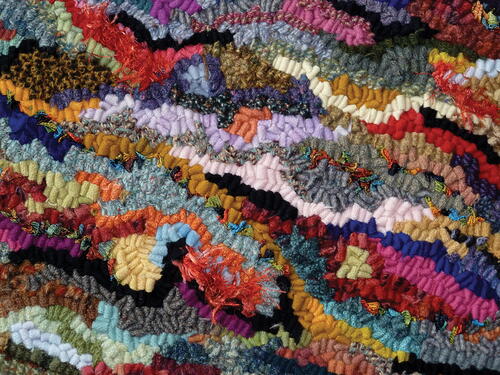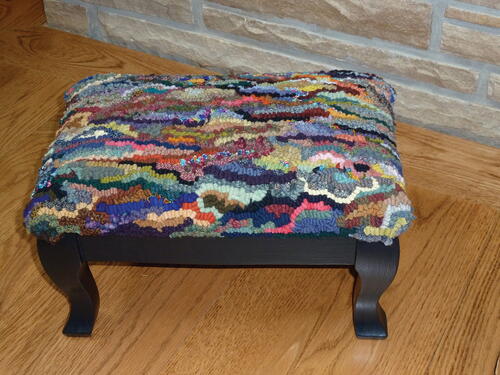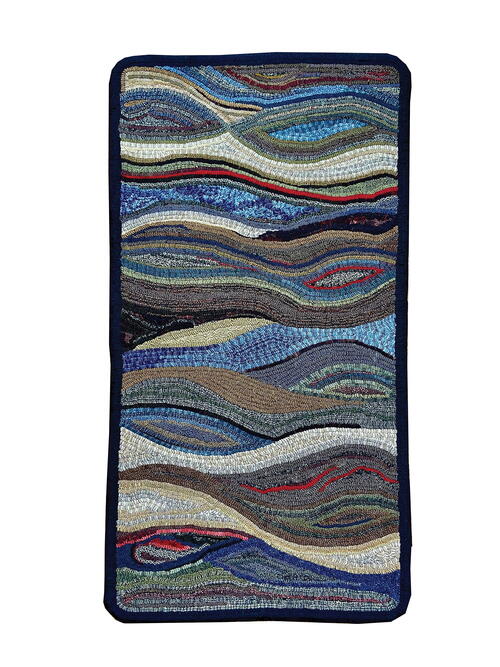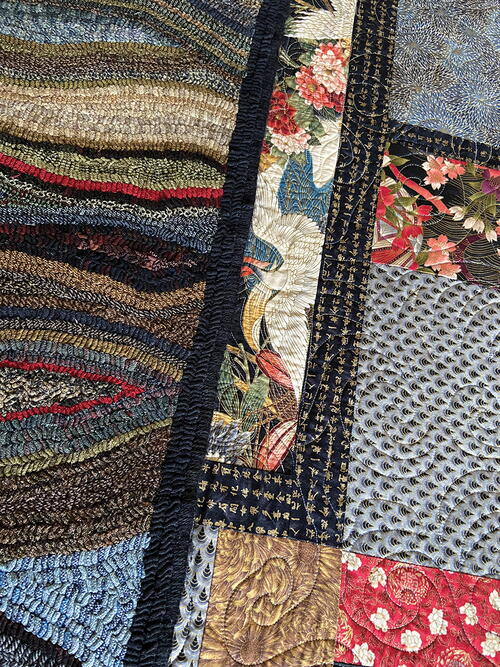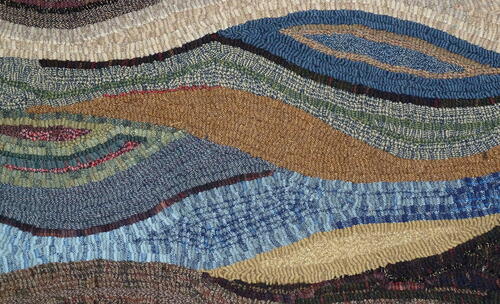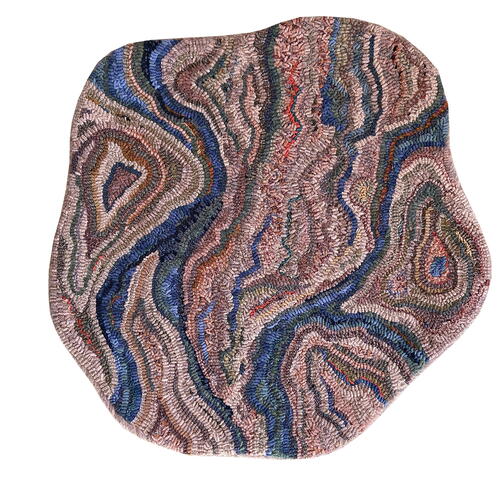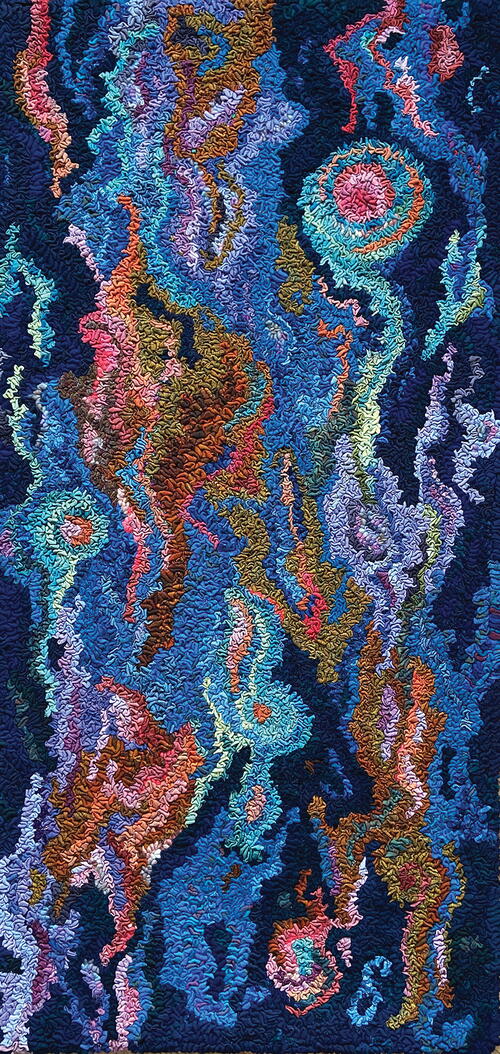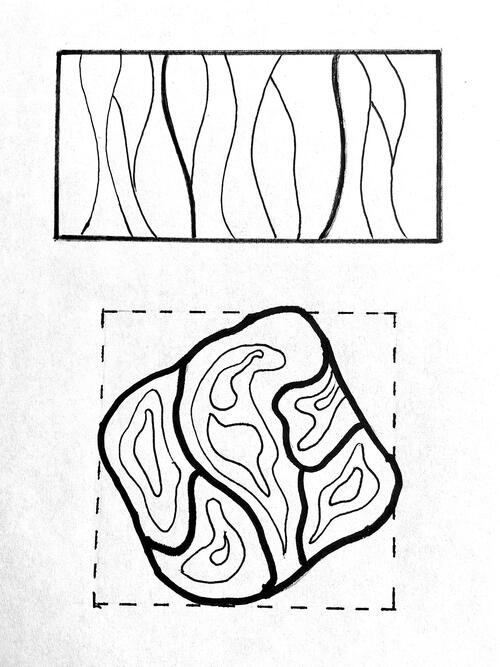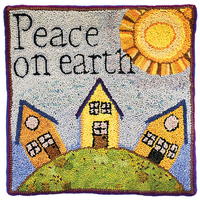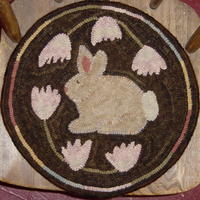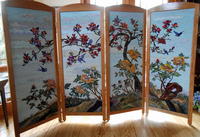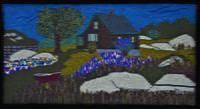Meandering into the Abstract
Take a Break from Realism

Here is the question: Why go there? Traditional rug hooking is a perfect blend of decorative and folk arts. The combination of a functional item with artistic beauty is of double value. Whimsical motifs and scenes of everyday life elicit warm feelings in me. As the years have gone by, I have made dozens of wide-cut rugs in the folk-art style. I will continue to do so, but there’s still a part of me wanting to explore outside the traditions of our craft.
Meander along my path into the abstract. As you progress, you’ll be pleasantly surprised by how quickly you release the notion of “I should”. Freedom to hook with minimal pre-planning is only one of many reasons to “go there.” The first tip for success is to embrace the definition of abstract art.
Abstract art is, according to the Oxford Languages definition, art that does not attempt to represent external reality, but seeks to achieve its effect using shapes, forms, colors, and textures. This spells out the appeal of hooking an abstract. Reality is not a prerequisite. Works for me!
Let’s look at four approaches to hooking an abstract rug.
-
NUMBER 1: HIT-OR-MISS GONE WONKY If you’ve ever done a hit-or-miss rug, you are already on your way. A little variation in hooking style results in an abstract vibe. Go big. Go small. Grab your noodle stash and go!
Begin by stabilizing the rug’s shape. Use strips of the same width, but in various colors, to hook around the exterior edge. Going lengthwise, draw a 3-4" meandering line near the middle of the foundation cloth. That’s it—abstract design completed. Start with a long noodle. Hook along the line, but change the width, off and on, by hooking in a higgledy-piggledy fashion. The best advice I was given regarding this hooking technique is to simply turn the hook’s handle perpendicular to whatever direction you want to go, plunge it down into the linen, and pull up your loop. Eureka! You have changed the direction of the loops. Hook another noodle next to the first one but stagger the starting point. Continue hooking in this fashion, flipping the piece around every so often to hook in the other direction.
The rainbow of noodles eliminates any color planning. Bright or dull, short or long, wide or thin—every strip adds visual interest as you minimize your stash. -
Hit-or-Miss Gone Wonky. detail. Higgledy-piggledy hooking is the key. Novelty yarns and ribbon add to the fun.
-
Hit-or-Miss Gone Wonky. Ease into abstracts with a small project. 14" x 14" footstool.
-
Have you accumulated a stack of deconstructed wool clothes? What could be better than upcycling them into a utility rug. The perfect opportunity for an abstract rug!
NUMBER 2: RIDE THE WAVE
While similar to a geometric, this design doesn’t require rigid measurements. The Wave bedside rug is stepped on everyday.
A quilt provided the color palette. Find your own color palette within a room. It might be a decorative vase, accent pillow, wallpaper, or painting. This stye of abstract benefits from the use of fewer colors in larger areas. That odd blue plaid skirt can be cut into strips. Divide into light and dark piles so you have extra shades of one color. Incorporate a small amount of an unexpected bold color to add drama.
Divide the area of the rug into thirds by drawing lazy, curved lines across the short width. The actual spacing of these areas should not be equal; for instance, if the rug length is 36", draw a line 10", then 14". The last section would be 12". Longer rugs can be divided into more areas, but keep the total sections an odd number. Draw a few more random curved lines within each section. This will give you some guidance as you hook, but adhering to the lines is completely optional. You may want to add more lines as you proceed. Hook a stabilizing row or two of loops around the exterior edges in the same color as your binding material. Proceed into the Zen mode of hooking along those long, curved lines. It reminds me of hooking a background, but without the boredom of hooking the same color for hours.
-
Ride the Wave, 27" x 51", #8.5 cut wool from clothing. Designed and hooked by Sharon H. Oppegard, Greenwood Village, Colorado, 2014.
NUMBER 3: GEODE FLOW
Nature offers an abundance of inspiration for the aspiring abstract rug artist. From the earth to the sky, there are opportunities to develop an abstract rug. Your realistic photograph can be distorted to an abstract vision. (Hmmm. It’s possible, but more work than I want to do.) Next stop: the Internet.
Search “geode rock images.” Varied in their shape and colors, it’s hard to believe they are real. We aren’t going for realism in our abstract world. Embrace the abstract shapes, pick your fantasy shapes, and hook away.
This table mat uses several different geode-like shapes together. The mat needed to be a particular size, so I drew a square, then the irregular shape was drawn within those borders. Once again, the overall shape is divided into an odd number of different sized spaces, with one being more dominant.It is completely optional to draw more lines within each section before starting to hook. Each section was an adventure into the unknown and pure joy to watch develop. I used beautiful new wools. The overall color scheme was limited to a muted variety of green, brown, cream, and rose. The blue added definition, and the surprise pop of color came from coral chiffon fabric. Wool textures work well to achieve a nature-inspired abstract, while solid, marbleized, and spot-dyed wools can give the same design a more graphic, modern look. Wool binding sewn onto the linen prior to hooking is an easy way to finish an irregular shape. Whipping with yarn works, too.
-
Color planning made simple. The quilt on the lower part of this photo was the color inspiration for the rug on the top.
-
Wave, detail: The area of light blue progressing into a darker blue is one plaid fabric, stripped and separated into different values.
-
Geode Flow, 24" diameter, #6- to 8-cut wool and some chiffon on linen. Designed and hooked by Sharon H. Oppegard, Greenwood Village, Colorado, 2020.
NUMBER 4: INTENTIONALLY UNINTENTIONAL
Previous experience builds the confidence to go even farther into the abstract. Convergence was started with two intentional goals. The first was to use only materials I had on hand. The second goal was to have no preconceived plan regarding what I would hook. I would begin my hooking on a completely blank canvas.
I had been saving wools which I deemed too lightweight for most rugs. Many were plaids from clothing or bolt yardage. None of them were likely to be used in my folk-art rugs. I overdyed some of these wools in my favorite colors, casting aside any concerns about whether they would “go together” or not. One particular plaid was a light cream color. I dip dyed it in very long strips in a variety of colors. This was extremely useful for adding interest within larger areas of a single color. The darkest areas are a mix of many navy plaid skirts. Other materials include wool roving, velveteen, velour, and a silk scarf.
I started hooking in the center area of the rug linen. To accentuate the feeling of movement, I used predominately 3/4" torn strips. The lighter-weight wools curve into themselves. I hooked in a meandering style but kept in mind to stick with mostly analogous colors in a particular area. Then I would switch to another group of colors. It is important to keep some wool from each color group for each third of your rug. It doesn’t need to be equal amounts, but the eye needs to catch bits of each color as it moves around the rug. The entire rug could have been hooked in meandering loops, but after a third of the rug was hooked, I decided to add some repetitive shapes. Not being able to see the entire rug on the frame at one time, I needed to draw these shapes on the linen for placement. Occasionally remove the rug to look at your hooked area. You may see the need to introduce or remove a color.
-
Convergence, 27" x 53", wide torn wool (as-is, overdyed, and dip-dyed) with wool roving, velvet, velveteen, velour, and silk scarf on linen. Designed and hooked by Sharon H. Oppegard, Greenwood Village, Colorado, 2022.
WHY HOOK AN ABSTRACT RUG?
■ Abstract art does not have to have a meaning. It is truly in the eyes of the beholder to ascertain what it means. One person may see actual objects. The next person envisions a place. Another only feels an emotional reaction to the work.
■ The beauty of an abstract rug is that there is no up or down, no “this way is right.” You can enjoy it in any direction. Turn this magazine 90 degrees as you view each rug. The rug will take on a different look, probably evoking a different response to it. Turn it again, and then again. Display your rug in one direction and change it as the mood strikes.
■ There is no expectation of a right way to hook an abstract. Success is in the feeling. RHM
-
Drawing lines for a wave design (above) and geode design (below). Use these as a starting imspiration or draw your own.
Sharon Hanford Oppegard is a self-proclaimed fiber-art addict. Thankfully, there is no cure. A wonderful community of rug hookers feeds her addiction and soul.


